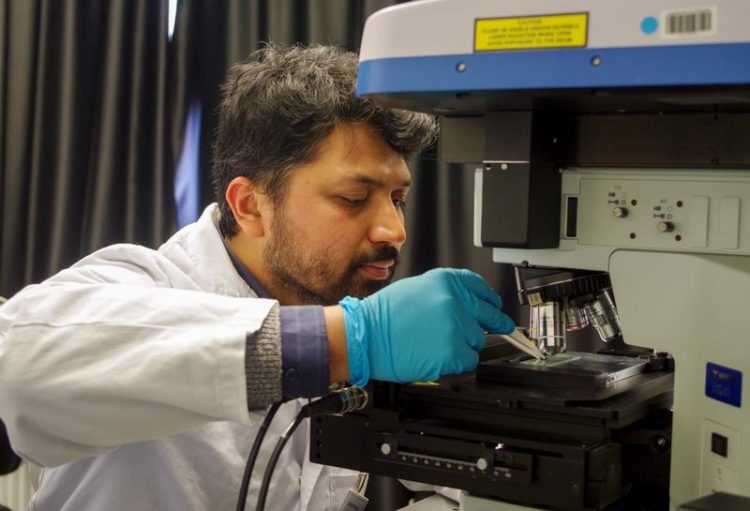Highlight in Semiconductor Research

TU researcher analyzes ultrathin gallium(II) selenide using Raman spectroscopy. Photo: Lars Meese
With his scientific article entitled “GaSe oxidation in air: from bulk to monolayers,” Mahfujur Rahaman has made an important contribution to physics research in the field of semiconductors. Rahaman is a doctoral candidate in the Professorship for Semiconductor Physics (Prof. Dr. Dietrich R.T. Zahn) at Chemnitz University of Technology.
His work was recognized as one of the highlights of 2017 by “Semiconductor Science and Technology,” a scientific journal specializing in semiconductors and their application. The jury evaluated his study according to various criteria, including presentation of outstanding research, popularity with online readership and high praise from referees.
With his scientific work, the TU researcher has opened the door to an even better understanding of ultrathin GaSe material and has thereby made an important contribution to the development of new GaSe-based technologies in nanoelectronics. “I feel very honored to receive this recognition and that my work is nominated as one of the best among so many outstanding scientific publications in this journal,” said the Chemnitz-based physicist proudly.
Important contribution to understanding of ultrathin GaSe materials
Two-dimensional semiconductors have undergone rapid development in recent years and possess great potential to replace current state-of-the-art silicon-based components- and thereby herald a new era in nanotechnology. Particularly from an economic perspective, two-dimensional semiconductors are very much in demand:
“These materials are thinner than the silicon that is commonly used and also less expensive. Apart from that, they also exhibit higher electron mobility,” explains Mahfujur Rahaman.
For this reason, he is conducting research on the physical characteristics of gallium(II) selenide (GaSe) – a highly promising two-dimensional semiconductor – under the direction of Prof. Zahn. Using three different spectroscopic techniques – Raman spectroscopy, photoluminescence and X-ray photoelectron spectroscopy – the physicist studies the properties of single- and multi-layered GaSe. The material, with a thickness of approximately one nanometer, is around one hundred thousand times thinner than a human hair.
Rahaman’s study showed that a single layer of the chemical compound oxidizes immediately when exposed to oxygen. However, when more than three layers are used, all GaSe layers beyond the third are protected from oxidation and remain stable.
More information is available from Mahfujur Rahaman, phone 0371 531-33298, e-mail mahfujur.rahaman@physik.tu-chemnitz.de and Prof. Dr. Dietrich R.T. Zahn, phone 0371 531-33036, e-mail zahn@physik.tu-chemniz.de
Media Contact
More Information:
http://www.tu-chemnitz.de/All latest news from the category: Physics and Astronomy
This area deals with the fundamental laws and building blocks of nature and how they interact, the properties and the behavior of matter, and research into space and time and their structures.
innovations-report provides in-depth reports and articles on subjects such as astrophysics, laser technologies, nuclear, quantum, particle and solid-state physics, nanotechnologies, planetary research and findings (Mars, Venus) and developments related to the Hubble Telescope.
Newest articles

Silicon Carbide Innovation Alliance to drive industrial-scale semiconductor work
Known for its ability to withstand extreme environments and high voltages, silicon carbide (SiC) is a semiconducting material made up of silicon and carbon atoms arranged into crystals that is…

New SPECT/CT technique shows impressive biomarker identification
…offers increased access for prostate cancer patients. A novel SPECT/CT acquisition method can accurately detect radiopharmaceutical biodistribution in a convenient manner for prostate cancer patients, opening the door for more…

How 3D printers can give robots a soft touch
Soft skin coverings and touch sensors have emerged as a promising feature for robots that are both safer and more intuitive for human interaction, but they are expensive and difficult…





















